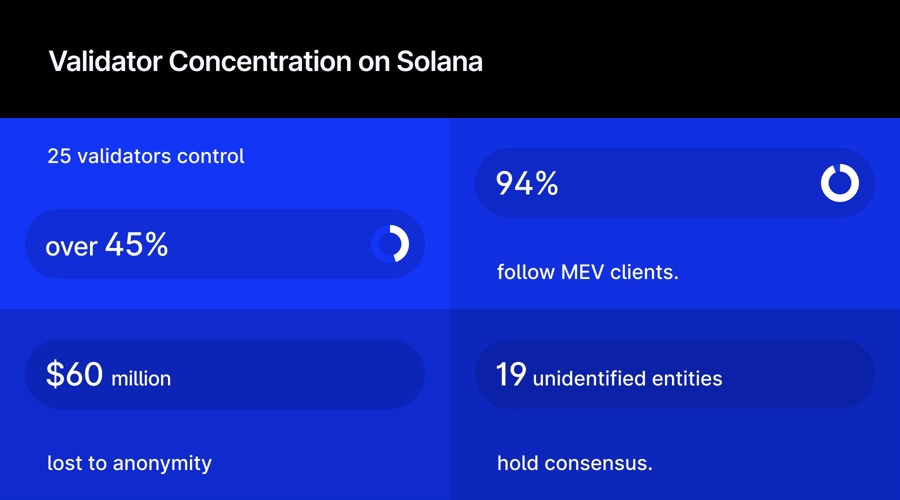While protocol teams obsess over validator counts and
geographic distribution, they ignore accountability through identity. The top
25 Solana validators control 45.5% of all stake, yet users delegating billions
cannot identify them or assess alignment with network values.
One anonymous
validator extracted $60 million through MEV attacks with impunity, and networks
like Aleph Zero show how critical disputes escalate when users cannot
distinguish leadership factions.
The Fundamental Flaw in Faceless Validation
The blockchain industry has conflated technical
decentralization with meaningful decentralization, creating systems that appear
distributed while operating with concentrated, unverifiable power structures.
Digital
assets meet tradfi in London at the fmls25
Anonymous validation enables “accountability
arbitrage,” where validators capture economic benefits of network
participation while avoiding reputational costs for their decisions. When 94%
of Solana validators adopt MEV-optimized clients without community
consultation, it demonstrates how obscurity enables coordinated behavior that
undermines stated network values.
[#highlighted-links#]
This produces networks with the worst characteristics of
both centralized and decentralized systems: the opacity of traditional
institutions combined with the coordination challenges of distributed
governance.
What does it mean to have Lunar as a validator?At Lunar we have been in the space since 2019, we have worked with many of the leading ecosystems in various parts of their growth stages. As a validator we contribute with: Top devops teams and hardwareHosting events,… pic.twitter.com/WKmXumGrcP
— Tim Haldorsson (@TimHaldorsson) September 23, 2025
The Illusion of Stake-Weighted Democracy
Current validator selection mechanisms optimize for capital
allocation rather than governance capability, creating systems where economic
power translates directly into political control without corresponding
accountability. Solana’s 19-validator Nakamoto Coefficient exemplifies this: 19
unidentified entities can control consensus despite thousands of validators
participating.
Users delegate billions in assets to validators they cannot
identify, effectively recreating the trust assumptions of traditional finance
while stripping away its regulatory protections. This represents centralization
disguised as decentralization, concentrating power among entities that
explicitly avoid building community trust through transparency and public
verification.
Building Networks with Validator Authority
Smart networks will distinguish themselves through validator
curation strategies that align individual reputation with collective network
health. This requires treating validators as ecosystem partners whose brands
and capabilities complement strategic objectives. Figment’s institutional
success demonstrates how branded validators become ecosystem multipliers: their
relationships, expertise, and reputation create network effects beyond
consensus security.
Rethinking Solana’s validator client paradigm 💻On the latest @ValidatedPod, @Austin_Federa is joined by @1ultd, CEO @Syndica_io. They dive into Sig, a new Solana validator client being built in Zig that optimizes for reads & aims to make running validator nodes more… pic.twitter.com/1Pz2mtGfhP
— Solana (@solana) March 26, 2024
When validators have public brands, their success becomes
tied to ecosystem success in ways anonymous operations cannot replicate. They
become natural content creators and thought leaders who expand ecosystem
mindshare through their audiences.
During governance decisions, they provide
distributed expertise that improves decision quality while building community
confidence in network evolution. Most importantly, validators with public
reputations create market-based accountability mechanisms, where poor
performance carries reputational costs that extend beyond individual
operations.
What’s the problem with the crypto ecosystem’s growth? ↓Since 2017, our marketing campaigns have had a huge tangible impact in the space.Our contribution to various crypto ecosystems, including Polkadot, ICP, Rose, and others, has received positive feedback from project… pic.twitter.com/qVVKcKMZTX
— Lunar Strategy (@LunarStrategy) January 31, 2024
The Market Evolution Towards Transparency
Faceless validation represents a transitional phase in
blockchain evolution, a primitive attempt to solve coordination problems
without understanding human incentives. Market dynamics increasingly favor
transparency, with institutional demand flowing toward verifiable
infrastructure providers.
Networks that recognize this evolution early will
build sustainable competitive advantages through validator authority. Those
treating obscurity as a feature will find themselves competing for a shrinking
market of users willing to accept opacity in exchange for marginal yield. The
future belongs to networks where technical excellence combines with human
responsibility—where you know who secures your assets and why they deserve that
trust.
This article was written by Tim Haldorsson at www.financemagnates.com.
Source link
